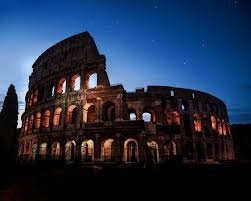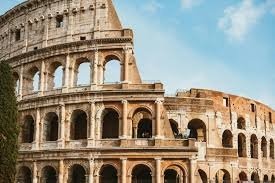When discussing the most iconic monument in Rome, one name rises above all others: the Colosseum. Also known as the Flavian Amphitheatre, the Colosseum is not only the symbol of Rome but also one of the most recognizable landmarks in the world. Standing as a testament to the grandeur of the Roman Empire, it embodies history, culture, and architectural brilliance, making it the most visited and photographed site in the Eternal City.
The Colosseum was commissioned in AD 72 by Emperor Vespasian of the Flavian dynasty and completed by his son Titus in AD 80. Built on the site of what was once Emperor Nero’s private lake, the Colosseum was intended as a gift to the people of Rome. With a seating capacity of between 50,000 and 80,000 spectators, it was the largest amphitheatre of its time and remains the largest ever built. Its design was revolutionary, featuring a complex system of vaults and corridors that allowed for efficient crowd movement—an engineering marvel still admired today.
The monument became the epicenter of Roman entertainment. Gladiatorial contests, animal hunts, and mock naval battles were staged to thrill the public and showcase Rome’s might. These spectacles were often brutal, reflecting the empire’s values of strength, endurance, and dominance. Beyond being a place of entertainment, the Colosseum symbolized Rome’s power and the emperors’ generosity toward their citizens, reinforcing their authority and popularity.

Architecturally, the Colosseum is a masterpiece. It measures 189 meters long, 156 meters wide, and 50 meters high, with its outer wall showcasing three levels of arches framed by Doric, Ionic, and Corinthian columns—a representation of Rome’s architectural sophistication. The hypogeum, an underground network of tunnels and chambers, allowed organizers to stage elaborate shows with hidden lifts and trapdoors. This innovation demonstrated the Romans’ unmatched engineering skills.
Over the centuries, the Colosseum has endured earthquakes, fires, and even stone looting during the Middle Ages, yet it remains an enduring symbol of resilience. Despite its partially ruined state, it continues to awe visitors with its grandeur and historical depth. In 1980, it was designated a UNESCO World Heritage Site, and in 2007, it was named one of the New Seven Wonders of the World, further solidifying its global recognition.
Today, the Colosseum attracts millions of tourists annually, serving as both a monument to ancient Rome’s glory and a reminder of its complexities, including the harsh realities of gladiatorial combat. It is also a modern symbol of peace; the Pope leads the annual Good Friday “Way of the Cross” procession at the site, transforming a place once associated with violence into one of reflection and hope.
In conclusion, the Colosseum is undoubtedly the most iconic monument in Rome. It represents the heart of ancient Roman civilization, combining history, architecture, and cultural significance. More than just a ruin, it is a living symbol of Rome’s legacy—reminding the world of the empire’s grandeur while continuing to inspire awe and admiration among millions who walk through its arches each year.




